In this in-depth CBD SEO case study, we’re going to break down how we’ve helped Natural Ways CBD add an extra $14k in monthly revenue and add over 1,800 people to their email list in a 10-month period.
What do you do when you’re a local CBD retailer that wants to go national?
Natural Ways CBD, a 5-location retailer in the Houston, TX, area chose to invest in search engine optimization (SEO), and they came to us to build and execute their strategy.
Hundreds of thousands of people use Google to buy CBD products – and find information about CBD products – every month.
By using SEO to become more visible, CBD brands can drive thousands in sales from ready-to-buy customers searching product-related keywords, while building email lists and driving additional sales from those looking for information about how CBD can solve a problem they have.
That’s what our client wanted to do when they came to us in August 2023, and this CBD SEO case study shows how we did it.
Growth Challenges Our Client Faced
Natural Ways CBD is a five-location CBD retailer. Their stores are placed in and around the Houston, TX, area. Per their name, they sell CBD, but they also sell delta 8 THC, delta 9 THC, CBG, CBN, and many other types of hemp-derived cannabinoid products.
Natural Ways CBD has their own line of premium hemp-derived products, but they also carry a plethora of products from other brands. Their customers love the fact that they can buy any product they need and have full confidence that it’s 3rd-party lab tested, safe, and effective.
Apart from their selection, Natural Ways CBD is also known for their amazing customer service. They treat their customers by family, and they don’t sell, they educate.
Natural Ways CBD’s employees are all well-educated about the cannabis/hemp plant, and by listening to their customers’ needs and answering their questions, Natural Ways CBD is able to recommend the best product for each person’s unique situation.
But while their retail business was booming and they had droves of happy customers, Natural Ways CBD’s online store was essentially a non-factor in their business.
Despite having a professionally-designed website and over 50 products available to ship nationwide, the only online sales Natural Ways CBD got were from customers who’d previously purchased in-store, and from a few chance search rankings.
Their online sales were stagnant at best and unpredictable at worst – and unpredictable is bad news for any business initiative in the CBD and cannabis industry where there’s already enough volatility.
Between risks that entire product lines could be made illegal or that the various platforms they relied on to run their business might shut their accounts down, Natural Ways CBD’s owners knew they needed to work relentlessly not only to increase their revenue, but to increase the number of ways in which they made revenue.
They saw an opportunity to reach customers nationwide with SEO and drive revenue through their online store, so they came to us.
And they had a huge opportunity. We took them on as a client because:
- They had dozens of products online, and we knew we’d be able to find easy opportunities for at least some of them to rank
- They had a strong existing customer base and decent amounts of direct traffic to their site, so they weren’t starting from zero and we’d be able to get them an ROI on a reasonable timescale
The rest of this CBD SEO case study lays out how we designed their SEO strategy, how we executed, and the business results it’s driven for them.
Our Approach: A Conversion-Focused SEO Strategy
In response to Natural Ways CBD’s goal to grow their online store into a consistent customer acquisition source, we got to work building a conversion-focused SEO strategy that would allow them to get sales from ready-to-buy searchers while getting email signups from soon-to-buy searchers.
But there’s a lot that goes into building a CBD SEO strategy before a single keyword is chosen.
1. Company & customer research
Every time we begin working with a new CBD SEO client, we start by researching their company and target customers before we dive into keywords.
Most CBD brands have a unique customer that they’re targeting.
This customer might be defined along the dimension of age (young, middle-aged, older), pain point (pain, anxiety, etc.), region (West Coast, New York, etc.), or pretty much any group that people belong to or identify with.
We needed to deeply understand Natural Ways CBD’s target customer so that we could:
- Provide this customer with what they want once they land on the site
- Find unique opportunities to be visible to this customer
To get an understanding of who they were targeting, we interviewed Natural Ways CBD’s founders and employees and asked questions like:
- What issue does this target customer have that your products solve for them?
- Which products solve which issues, and for which specific customers?
- What has this target customer tried for this problem that hasn’t worked?
- What forms of medicine, whether traditional (drugs) or alternative, has this person tried?
- What are they switching off of?
- What type of CBD or cannabis user do your customers tend to be (recreational or therapeutic)?
- What dimension do you primarily define your target customer along (age, pain point, etc.)?
- The other groups your customers tend to fall into (e.g. if you’re targeting middle-aged people, do you serve more middle-aged men or middle-aged women)?
We also asked more specific questions related to purchasing behavior:
- What makes your customers buy?
- What is their reason for buying?
- What is the “aha” moment that tips them over the edge and makes them decide to complete the purchase?
- Why do customers choose your business over another?
- Prices?
- Quality?
- Resonance with your brand message?
And here’s a bit of what we learned:
- Given that they are a generalist retailer, Natural Ways CBD’s customers come to them with all manner of issues, with the most common being sleep, pain, and anxiety.
- Natural Ways CBD’s customers are both recreational and therapeutic, but tend to skew toward therapeutic users who are more interested in fixing a problem than getting the strongest high.
- Their customers are similar primarily in the issues they have (i.e. pain point is their primary dimension), and they span the age range, with recreational users skewing younger and therapeutic users skewing middle-aged and older.
- Natural Ways CBD’s customers buy to solve a problem, and their “aha” moment typically occurs after they get an in-depth explanation of how a certain product can help with the issue they have.
- Natural Ways CBD’s customers choose them because of their focus on customer service and fitting the solution to the individual, rather than the individual to the solution (as far too many companies try to do).
After getting thorough answers to all of these questions, we had a thorough insight into who Natural Ways CBD was targeting, attributes this customer tends to have, and the things that get this customer to buy.
This insight allowed us to write product copy that converted and blog content that resonated and generated email signups. It also allowed us to find unique content angles that no other brands had thought of pursuing.
2. Marketing strategy & SEO framework
With a clear view of Natural Ways CBD’s target customer, our next step was to think about what types of things this customer would be searching on Google.
To figure this out, we needed to remember the 10% rule: of all your potential customers, only 10% are ready to buy at any given moment. The other 90% won’t be ready to buy, but will instead be in the process of discovering how CBD and similar products can help them.
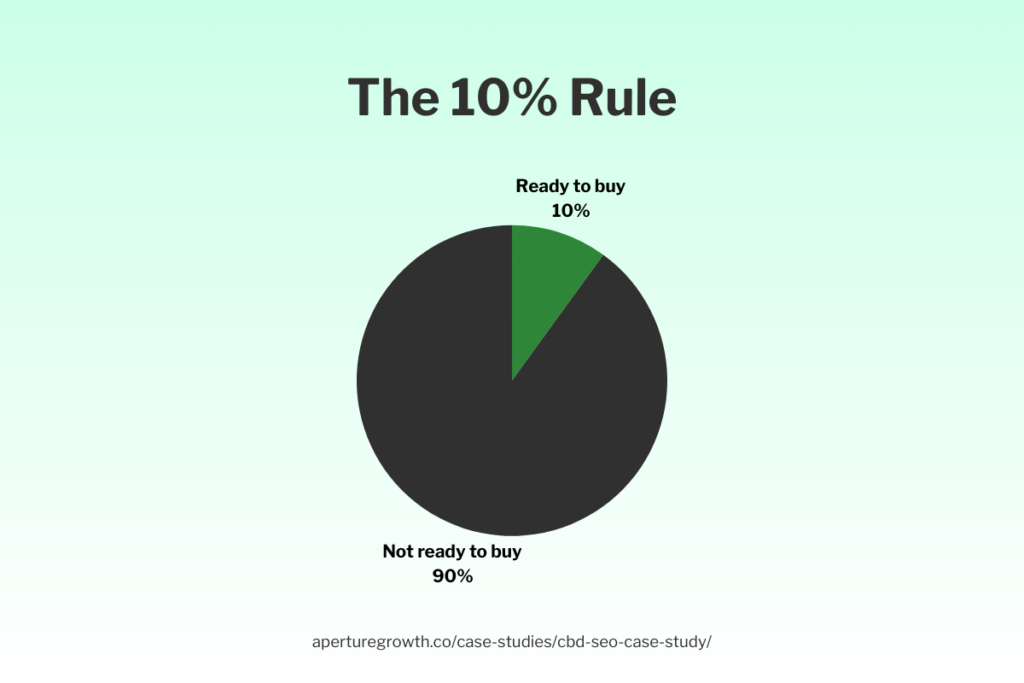
To be even more precise, you can map both types of potential customers to the marketing funnel, where the 10% who are ready to buy are in the bottom of the funnel (BOF) and looking to make a purchase, while the 90% are in the top of the funnel (TOF) and middle of the funnel (BOF) and either learning more about CBD (TOF) or researching how CBD, specifically, can help with their problem (MOF).
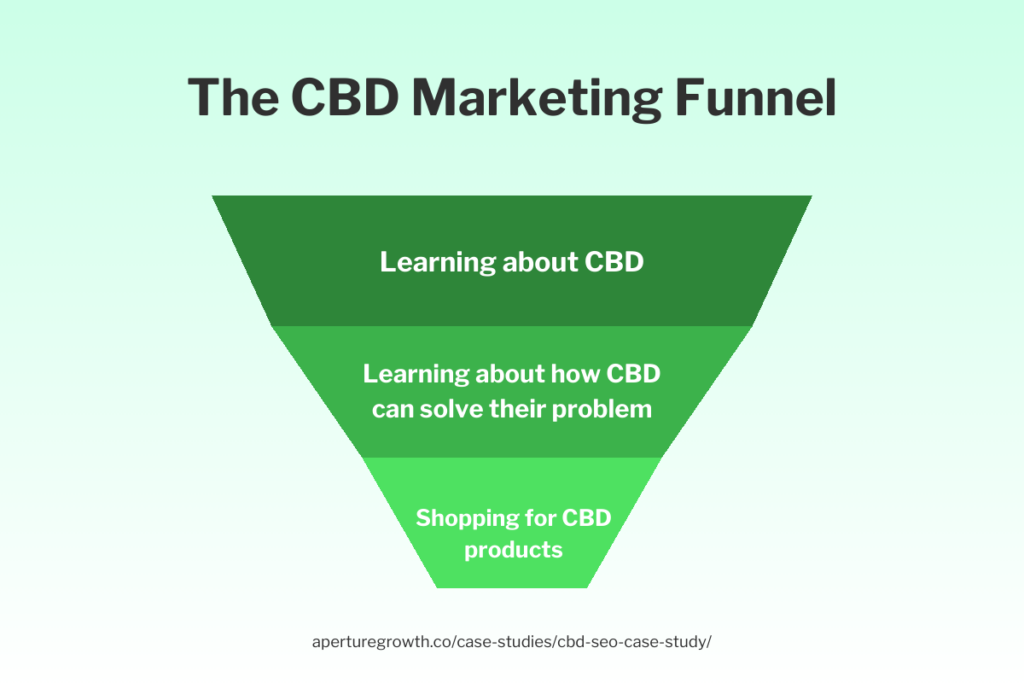
Now, the typical way TOF is described is that people in this stage are trying to identify their problem. In Natural Ways CBD’s case, those problems are typically physical or mental discomforts (pain, anxiety, insomnia, etc.).
However, we knew from the start that we weren’t going to be able to rank for medical terms that didn’t have to do with CBD, because these searches would be extremely competitive.
So instead, we designated TOF searches as being those which indicated someone knew about CBD products (and related), but wasn’t yet researching how these products could solve a problem they had.
Our goal was to make Natural Ways CBD visible to potential customers at every stage of the funnel.
Therefore, at a high level, our SEO strategy would consist of two primary parts:
- Product page optimization: This would allow Natural Ways CBD to be visible to people in the BOF who were looking to purchase products like the ones our client sells at that moment – the 10%.
- Blog content development: This would allow Natural Ways CBD to be visible to people who were likely to buy soon – the 90% – and capture their email, so that when they were ready to buy, Natural Ways CBD would be a highly preferred choice. Additionally, blogging would allow us to build up Natural Ways CBD’s topical authority for CBD and related topics. Google prefers to rank sites that are an authority on the topic someone is searching; we could build this authority with blog content, then reap the benefits of it because our product pages could then rank more easily.
3. Keyword strategy
With a basic idea of the levers we’d need to pull to make Natural Ways CBD visible to their target audience, it was now time to choose specific keywords to target with product pages and blog posts.
At a basic level, any keyword you’re going to target with a page needs to meet three criteria if you’re going to be successful in ranking for, and profiting from, it:
- The search intent of the keyword (i.e. the thing the person searching the keyword hopes to accomplish) must align with the page and page content you’re trying to rank for that keyword. If it doesn’t, you’ll need to find a different keyword. If you don’t find a different keyword, you’d need to use a different type of page or put different content on your page to rank.
- The keyword must be reasonably easy to rank for (a proxy is a difficulty score in tools like SEMrush or Ahrefs) so that you can begin seeing results on a reasonable timescale.
- The keyword must have reasonable amounts of search volume so that you’ll see traffic and business results once you rank.
We started with the product pages. For each product, we used the following process to find a good keyword:
- Using SEMrush, we searched the product name in different ways to see how people tend to search for the product.
- Example: Natural Ways CBD sells full-spectrum CBD gummies with 50mg CBD per piece, so one keyword we researched was “50mg cbd gummies” (we ended up choosing it).
- Each time we found a keyword (which is really a group of keywords that all have the exact same intent) that seemed promising from a volume and difficulty standpoint, we manually searched it in Google to ensure the currently-ranking product pages were similar to the product page we were trying to rank (i.e. that the search intent was correct). If it met all three criteria discussed before, we noted it down in our spreadsheet along with its volume and difficulty.
- If, along with the head keyword and nearly-identical variants, SEMrush returned variations of the head keyword that seemed to indicate that someone was searching for a product that was slightly different from ours, we manually searched these keywords on Google and compared the results to the results shown on the head keyword. This would allow us to figure out whether these sub keywords were part of the main keyword and should be included in their volume and difficulty data, or should be excluded (as we wouldn’t end up ranking for them if we ranked for the head keyword).
- After we searched for the product in every way we could think of, and went through steps 2 and 3 for each promising head keyword, we went back into our spreadsheet and chose the keyword that offered the best balance of volume and difficulty. Generally, we were willing to make sacrifices on search volume (i.e. keywords with less than 100 searches per month) if the keywords were very easy to rank for.
Once we repeated these steps for all product pages and found good-fit keywords to optimize for, we moved on to doing keyword research for blog content.
Our keyword research process would be different for the blog posts because, unlike with the product pages, we weren’t trying to find keywords to fit existing pages. We hadn’t yet created the posts, so we had more latitude to decide which keywords to target.
In theory. In reality, for blog content to work, it needs to be written about topics that map to your products.
This is for two reasons:
- Writing about the same topics that your products are a “part of” allows you to build your website’s topical authority for these topics. Doing this will allow any page you create about these topics to rank higher, more quickly. While building topical authority isn’t an exact science, we typically see that it takes 10-12 in-depth posts on a topic to establish your site as an authority on that topic in Google’s Ranking Systems.
- From a logical standpoint, you need to write content that addresses questions people have about the specific types of products you sell so that the traffic you’ll bring in is relevant and will convert to email signups or sales.
Therefore, we needed to target blog keywords that mapped to the products Natural Ways CBD sells, and we needed to write enough blog posts in each topical “silo” to build authority and allow their product pages in those silos to rank better.
Generally, CBD and cannabis brands need to think about topical silos in terms of the different product ingredients.
This is because most companies sell a single cannabinoid in five different delivery methods (e.g. CBD gummies, CBD oil, CBD topicals, CBD drinks, CBD vapes), not a single delivery method with five different cannabinoids (CBD gummies, delta 8 gummies, delta 9 gummies, THCv gummies, CBN gummies).
In the first example, if you build authority on the topic of “CBD,” all of your product pages will benefit from that topical authority. But if you built authority on the topic of “gummies,” only one of your product pages would benefit unless all you sold was CBD gummies.
This is a bit in-the-weeds, but we included it because we want you to see the thought process behind deciding what to build topical authority on.
Since Natural Ways CBD sells CBD, CBG, CBN, delta 8, and delta 9 products, primarily, we decided to build authority on each of these topics. This meant we needed:
- About 10 blog posts about CBD
- About 10 blog posts about CBG
- About 10 blog posts about CBN
- About 10 blog posts about delta 8 THC
- About 10 blog posts about delta 9 THC
In some cases, there weren’t 10 distinct topics which all needed a post, so we would write fewer than 10; our goal was just to write at least 10 posts on topics that have a seemingly endless number of subtopics (CBD).
With this in mind, we began finding out what, specifically, these subtopics should be. After typing each head topic in and seeing what types of informational keywords were out there, we built keyword patterns that would allow us to find lots of ideas easily.
For top-of-the-funnel (TOF) blog posts, which were built to reach people researching cannabinoids before considering their use, some of these keyword patterns (with examples) included:
- [cannabinoid] vs [cannabinoid]
- CBG vs. CBD
- CBN vs. CBD
- CBD vs. delta 8
- [cannabinoid] side effects
- CBG side effects
- CBN side effects
- CBD side effects
- Does [cannabinoid] get you high
- Does CBG get you high?
- Does CBN get you high?
- Does delta 8 get you high?
For the middle-of-the-funnel (MOF) blog posts, where we were focused on people interested in how various cannabinoids could help with problems, we focused on keyword patterns like:
- [cannabinoid] for issue
- CBG for pain
- CBG for IBS
- CBG for anxiety
- [cannabinoid] vs [cannabinoid] for [issue]
- CBD vs. delta 8 for pain
- CBD vs. delta 8 for anxiety
- CBG vs. CBN for sleep
- [cannabinoid] vs [prescription drug]
- CBD vs. Ativan
- CBD vs. Lexapro
- CBD vs. Xanax
These aren’t the only sorts of keywords we targeted with blog posts, but keyword patterns like those above allowed us to consistently cover each main subtopic from the same angles.
Once we had these patterns established, finding individual topics was easy. We searched these patterns, dumped all the keyword ideas into a spreadsheet along with their volume and difficulty scores, then prioritized them by difficulty (easiest first).
4. Prioritization
Optimizing Natural Ways CBD’s product pages is the first thing we did to get some “quick wins” on the board for them and drive organic revenue early in our engagement.
We did keyword planning for the blog posts on a quarterly basis. In other words, every 3 months, we sat down and chose the keywords to target for the next quarter.
The basic timeline on which we executed was as follows:
- In the first two weeks, optimize every product page
- Then, start writing 1 blog post per week
- After six months, begin updating 1 blog post per week in addition to writing one
We also ran the following tests quarterly to maximize results for Natural Ways CBD:
- Quarterly title tag test: Testing new titles on low-performing pages to improve their click-through rate (CTR).
- Quarterly snippet test: Optimizing articles already ranking on the first page to appear in Google’s top-of-page Featured Snippets.
While not an exhaustive look at how we prioritize various activities in engagements with clients, this gives you an idea of how we go about deciding what goes first and what needs to happen on an ongoing basis.
Product Page Optimization
With Natural Ways CBD’s marketing strategy, SEO strategy, and keyword research on lock, we got to work optimizing their product pages.
Here are a few of the most impactful things we did to improve the performance of their product pages.
The title tag and meta description are the two primary elements that people see when you rank in Google’s search results:

Therefore, optimizing them for click-through rate (CTR) will help you get more traffic. But they’re also critical for ranking because Google uses these elements to determine what your page is about.
For Natural Ways CBD, we:
- Wrote title tags that were 60 characters or less (to avoid Google cutting our title off) that included our target keyword and a unique benefit of the product.
- Wrote meta descriptions that were 160 characters or less, included our keyword, and briefly described the benefits of the product and shopping with Natural Ways CBD.
These two changes boosted rankings and CTR for many of Natural Ways CBD’s product pages.
Rewriting product titles and descriptions
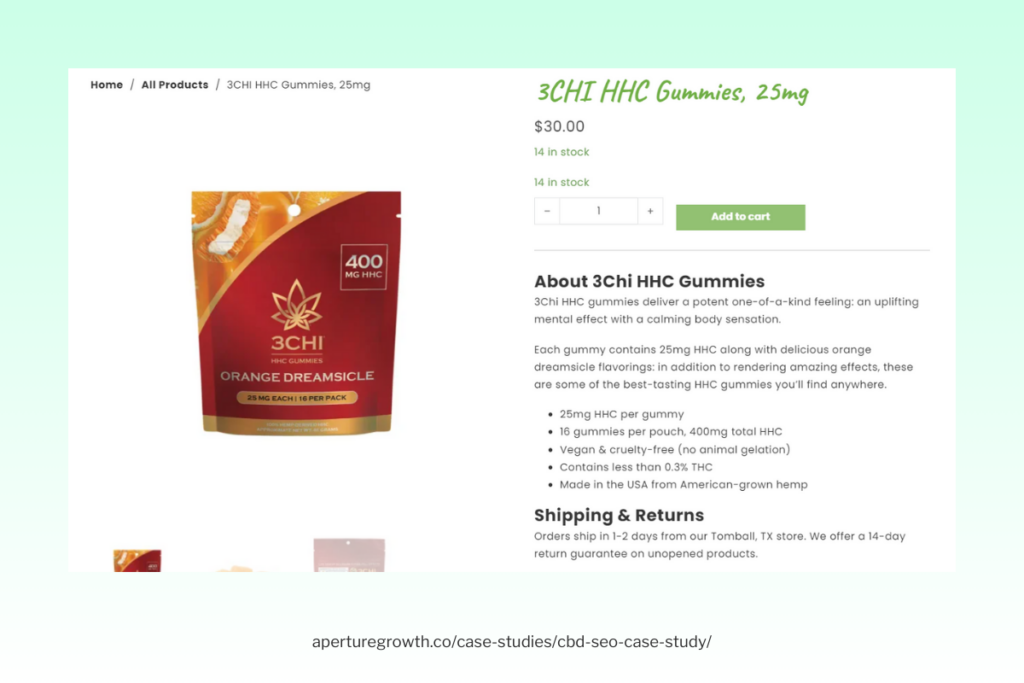
The product title on the page itself, as well as the product description, also serve a dual importance for user experience and SEO. They need to be descriptive and encourage people to buy, but they also need to contain your target keyword to reinforce to Google what your page is about.
However, we couldn’t rewrite Natural Ways CBD’s product titles (e.g. from “Full Spectrum CBD Gummies 25mg” to “25mg CBD Gummies”) because they were linked to their in-store retail system.
But we were able to rewrite their product descriptions and on-page content.
For each product, we:
- Added the target keyword 2-3 times in the description
- Ensured the description focused on the problems each product solves and the benefits it offers (versus just on its features) so that people would clearly see the value of the product and imagine themselves using it.
- Ensured the description contained sizes, strengths, and lab test links so people knew exactly what they were getting.
- Added shipping and returns info to the product descriptions to increase people’s certainty about their purchase.
We did a bit of SEO optimization here, but most of the work we did was focused on providing a better shopping experience to people, and this ends up improving SEO:
- Providing complete information on product pages results in people buying your products more often, or, at the very least, spending more time on these pages. Engagement and time-on-page influence how well Google ranks your pages.
- Providing shipping and returns information on your product page often results in Google showing this information on your search result, which increases click-through rates, which are correlated with higher rankings.
This same sort of virtuous cycle where user experience improvements result in SEO improvements can be seen in just about every part of SEO, but it’s especially strong with product pages.
This is why we focus so heavily on ensuring our clients’ product pages, at a minimum, have complete information.
Refreshing product media
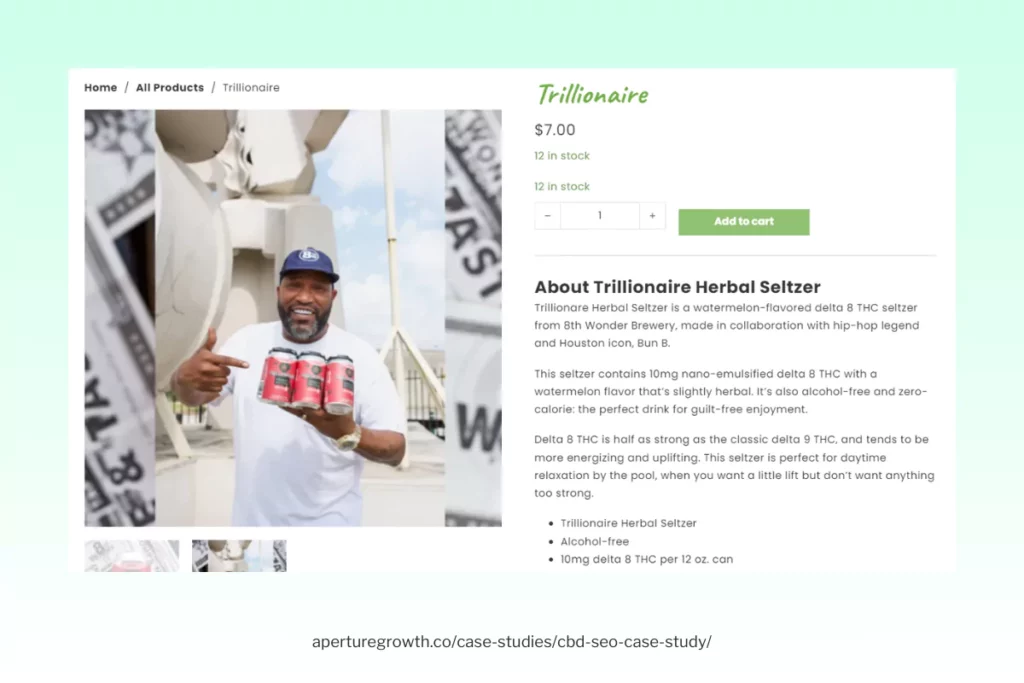
The way a product looks plays a major role in whether someone decides to buy it.
And if your CBD brand is particularly attractive to the eye, the look and “feel” of your product will play an outsized role in someone’s decision to purchase.
Therefore, high-quality product images are, in our eyes, a requirement for every brand selling online.
Ideally, your product pages contain high-quality images of the front of your product and the ingredients section of the label, as well as “lifestyle” images of your product in use by real people.
But even if you don’t have the photography or design talent (or budget) to shoot all these images, at a minimum, the images you have should be:
- High-resolution (not blurry)
- Consistent across products
If you can’t do this, there’s very little chance that someone will see your brand as trustworthy, legitimate, and worthy of their business.
While Natural Ways CBD couldn’t provide lifestyle photos for every product, we edited and remixed their current images to make them higher-quality and more uniform.
Remapping internal links
Earlier in this article, we discussed topical authority at link. While writing helpful content on a topic can result in a general, side-wide lift in rankings for pages that relate to that topic, this effect is strongest when this content links to the related pages.
That’s why, once Natural Ways CBD’s product pages were fully optimized for search engines and real people, we added internal links to them from related blog posts (we did for each product page each time we published a new piece of relevant content).
This directly allowed us to improve the search rankings of Natural Ways CBD’s product pages.
Blog Content Development
After we optimized Natural Ways CBD’s product pages, we began our ongoing initiative to publish and update new content.
Here are a few key things we did – whether once or on an ongoing basis – to drive business results for Natural Ways CBD through the content we produced.
Email sign up form installation
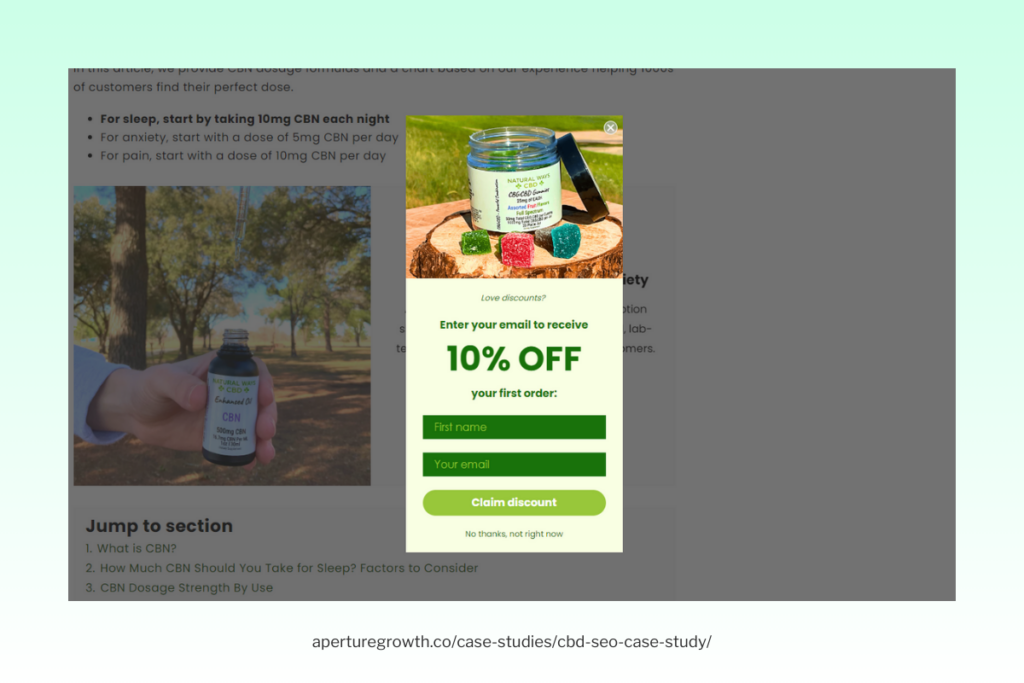
Natural Ways CBD already had a pop-up form in place with a simple offer: 10% off your first order if you sign up. We loved the offer, but didn’t love the design of the form.
So we built a new form that featured a picture of their products front-and-center; if it was going to show for every new visitor, it needed to look good.
Then, we duplicated that form and showed one copy of the form on blog posts, and the other everywhere else. This way, we could track the impact of our blog posts on their email list growth.
SERP analysis
Every new piece of content or content update that we did for Natural Ways CBD started with an in-depth search engine result page (SERP) analysis.
In this analysis, we reverse-engineer the top ranking results to determine what needs to be included in our article for it to rank.
This is a core part of our CBD content writing process.
In the SERP analysis, we at things like:
- What topics the titles of the top-ranking articles mention & how these titles are written
- The queries in the Google search bar that are “autocompleted” after we type in our keyword
- The questions that show up in Google’s “people also ask” result
- The topics covered in the articles ranking in the top 5 or top 10 and how often each appears
Based on this information, we built outlines that established the bare minimum that we had to include in Natural Ways CBD’s articles for them to rank.
We then used internal insights and research to further improve this outline, with the goal being for it to be more logical, more complete, and more helpful than anything else that was out there.
Research process
While an SEO-optimized outline is one of the main ingredients in creating high-performing content, it’s only the starting point.
The research process you use is the difference between unique, differentiated content that people remember (and that ranks for a long time) and generic, bland content that ranks for a couple of months, then begins to drop out because it’s not very helpful to people.
For Natural Ways CBD, we pulled from several sources to ensure each piece of content we produced would be the most helpful on that topic:
- Their in-house staff: We conducted interviews with Natural Ways CBD’s owners and employees numerous times to learn about their perspectives on the topics we were writing about. Customers ask them questions about CBD and other cannabinoids every day; we wanted to know the answers they were giving these customers.
- Reddit: In the CBD space, people want firsthand experiences, not a summary of research and a vague, generic conclusion. We got some of this experiential insight by searching each topic on Reddit and seeing what people were saying. This gave us additional perspectives to consider and experiences to recount, which made Natural Ways CBD’s content far more engaging and informative than it would have been otherwise.
- Scientific journals: Given that Natural Ways CBD focuses heavily on the therapeutic benefits of hemp-derived products, with rare exception, the articles we produced for them were based on, and cited, scientific research. We primarily pulled studies from the National Institutes of Health website, and weaved this research into our content carefully to avoid making medical claims.
Custom visual and interactive assets
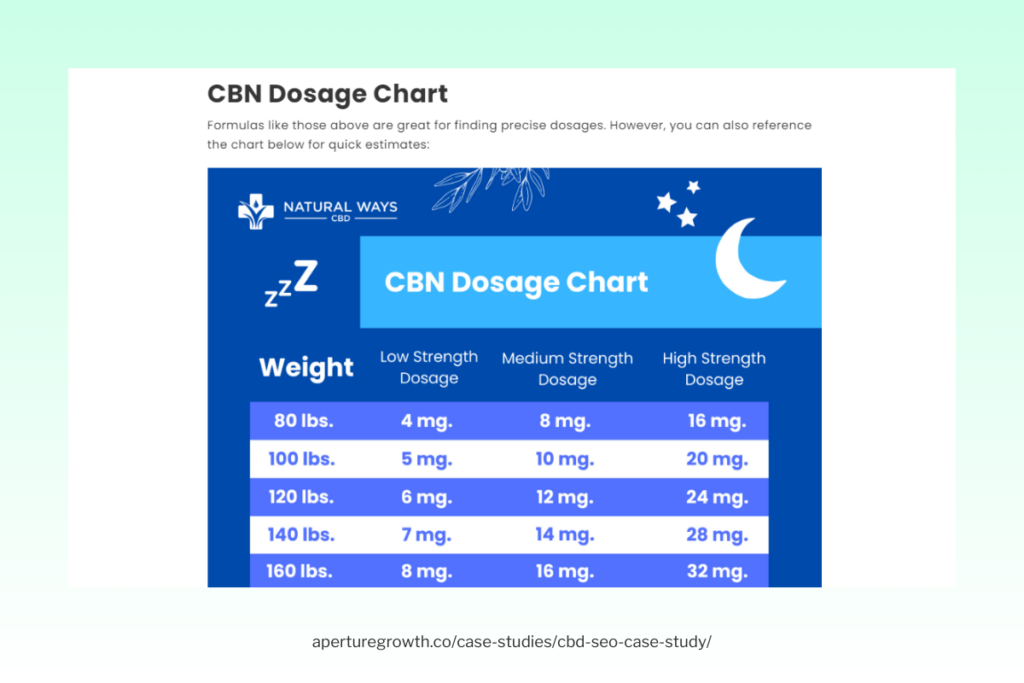
Every post we developed for Natural Ways CBD included images to provide context and “eye relief” to readers. But in many cases, we also created custom graphics and tools.
Some examples include:
- A graphic of the major terpenes
- A CBD dosage chart & calculator
- A comparison graphic between CBD and delta 8 THC
Often, these elements were what elevated their content beyond their competition and allowed them to get top-3 rankings for numerous keywords.
In one case, an article we wrote for them got several hundred clicks per month from Google image search, rather than regular organic search, because a graphic we created was the 1st image result for that search term.
Internal linking strategy
In itself, writing good blog content about a topic helps you build authority for that topic. The more angles of that topic you cover, the more of an authority on that topic Google perceives your website to be.
But only when you link related blog posts together and then link these blog posts to relevant product pages do you get the full benefit of this topical authority: your product pages (which make the real money) will rank higher, and your blog posts will, too.
Additionally, linking from existing content to newly-published content helps that new content get found, crawled, and indexed by Google. This means it will begin ranking and driving results sooner than it would have otherwise.
That’s why every new article we published for Natural Ways CBD linked throughout to the other content we’d created on that same head topic (e.g. linking an article about CBG for pain to an article about CBG for anxiety), as well 1-2 times to relevant product pages.
Then, we added links from at least 3-5 existing articles to each new article to help it get found and start ranking sooner.
Results from Our SEO Strategy
We started our full-service SEO program with Natural Ways CBD in August of 2023, and the results you see here are measured through May 2024 (a 10-month span).
Below, we’ve outlined key results we achieved for Natural Ways CBD in three different areas: revenue, email signups, and organic traffic.
We’ve also given examples of how product pages we’ve optimized, and blog posts we’ve written, are performing.
All data is measured through Google Analytics (filtered into a Looker Studio dashboard) and Google Search Console, with the exception being the email data, which is measured by Klaviyo (their email provider).
Revenue
In the six-month period before they began working with us, Natural Ways CBD made an average of $2,167.05 in organic revenue each month.
In May 2024, 10 months into our engagement, they made $15,658.05 in organic revenue, plus $741.40 in extra revenue from blog readers who didn’t come from organic search.
Our impact can be calculated by adding these numbers together, then subtracting what they made on average before we started working with them:
$16,399.45 – $2,167.05 = we added ~$14k in monthly revenue for Natural Ways CBD
RESULT: $14k in extra revenue per month
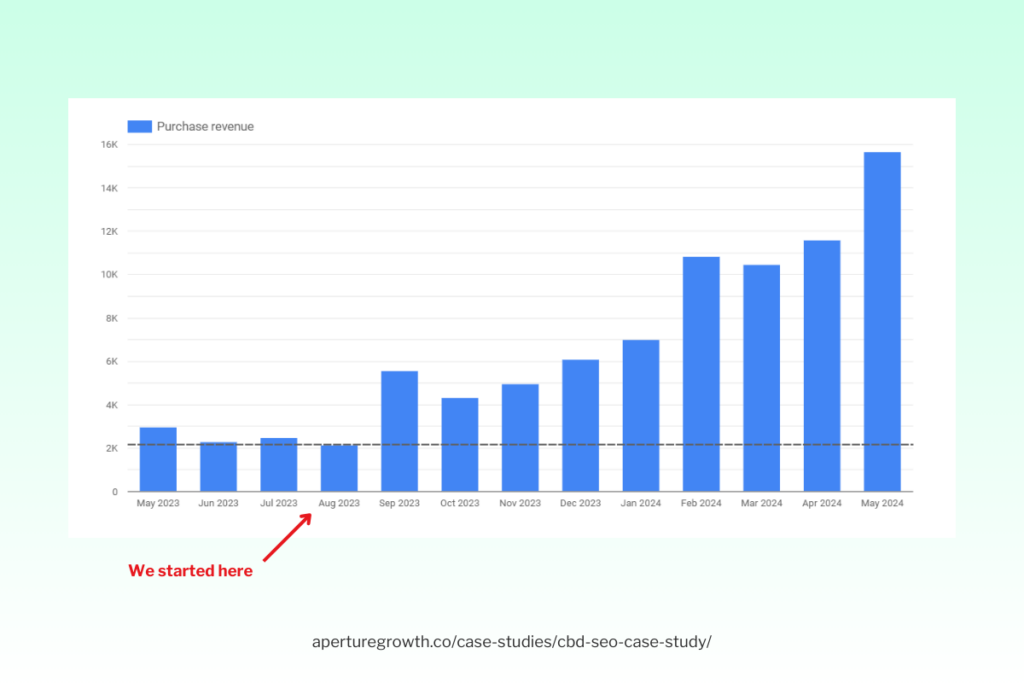
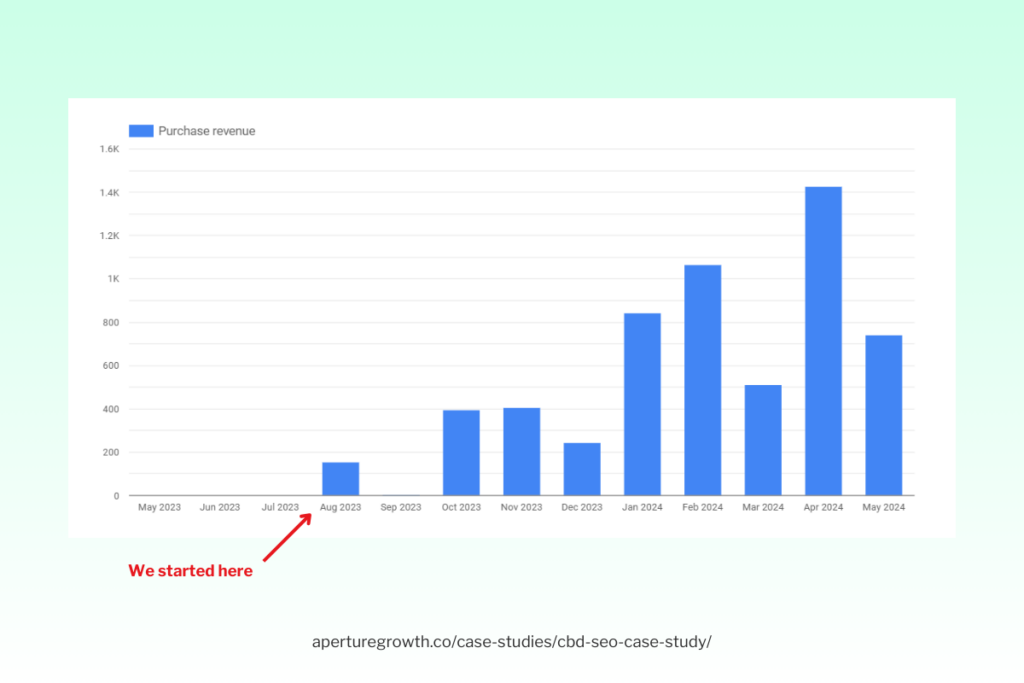
Email signups
From August 2023 through May 2024, our blog posts have generated 1,800 email signups for Natural Ways CBD, who saw 281 new email signups in the Month of May alone.
RESULT: 1,800 new email signups in 10 months
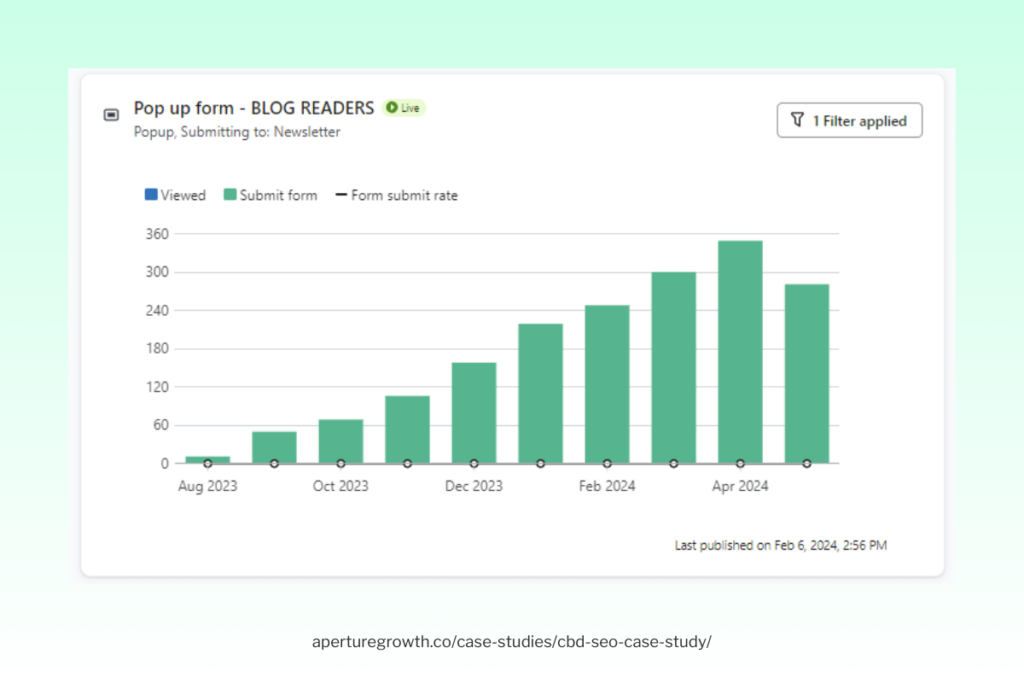
Traffic
In July 2023 (we started full-service SEO in August), Natural Ways CBD received a total of 2,998 sessions to their website from organic search.
In May 2024, 10 months into our engagement, they received 35,116 organic sessions.
RESULT: ~32,000 extra sessions per month
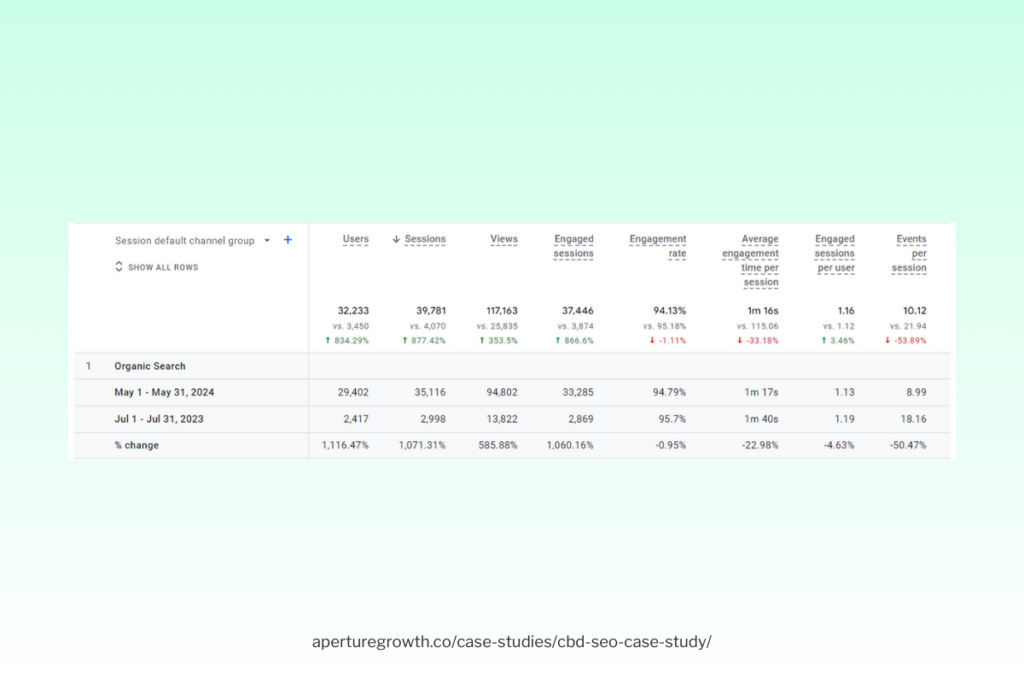
Product page examples
After being optimized a few months before, this product page received 2,000 clicks from Google search in 3 months:
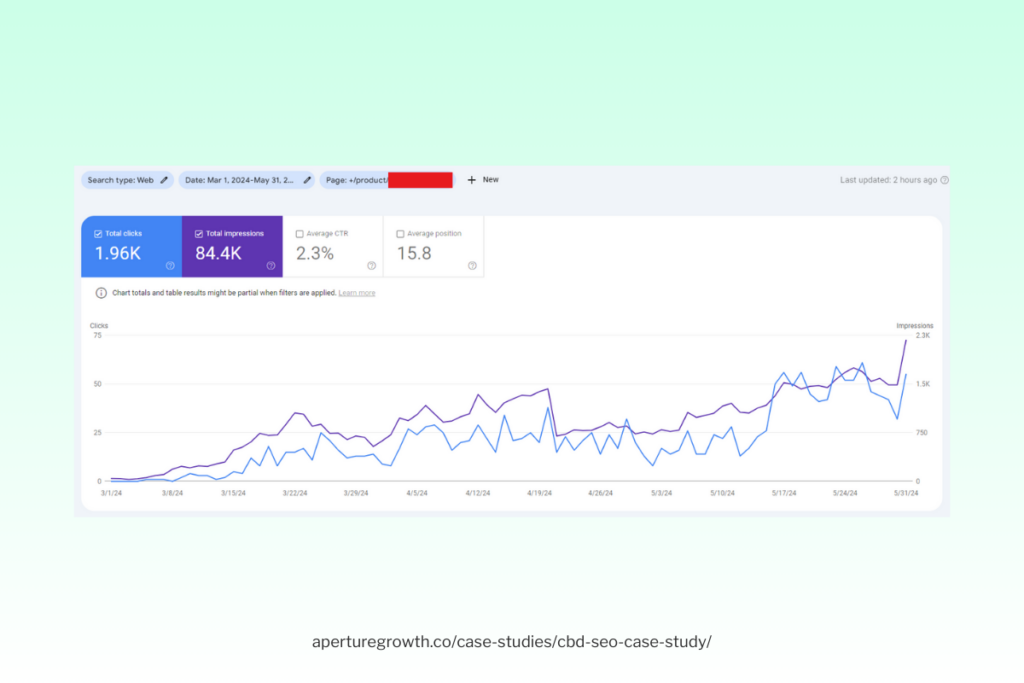
After being optimized in November 2023, this product page received 1,240 clicks from Google search with a near-4% click through rate between January 1st, 2024 and May 31st, 2024:
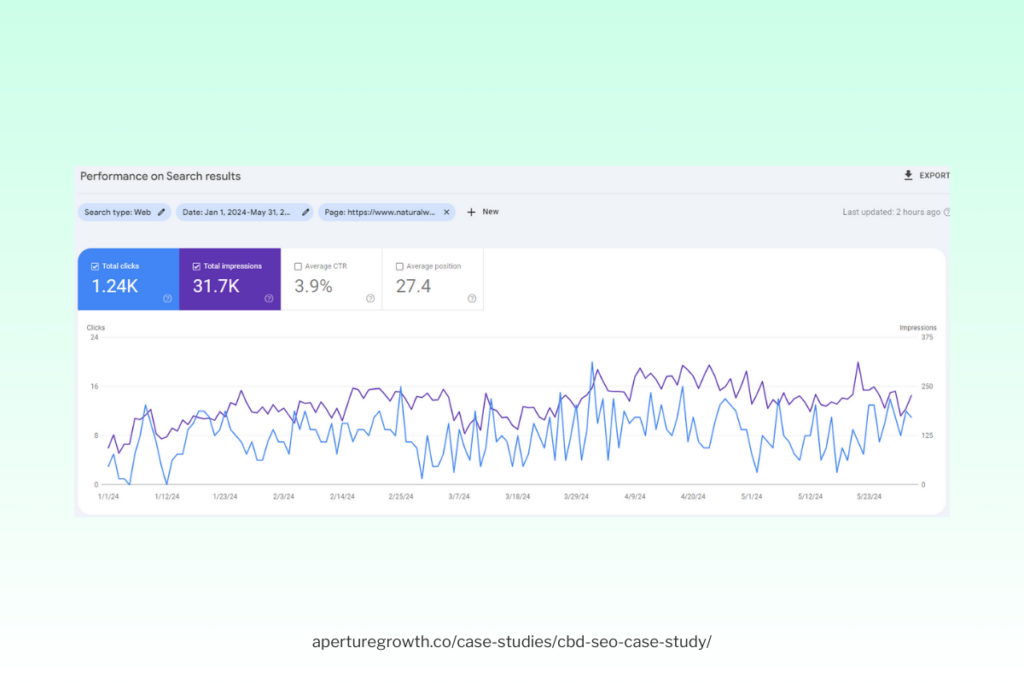
Between August 1st, 2023 and May 31st, 2024, this is what the growth in clicks of Natural Ways CBD’s products pages looked like:

Blog post examples
This blog post received nearly 20,000 clicks in the above-mentioned 10-month period:
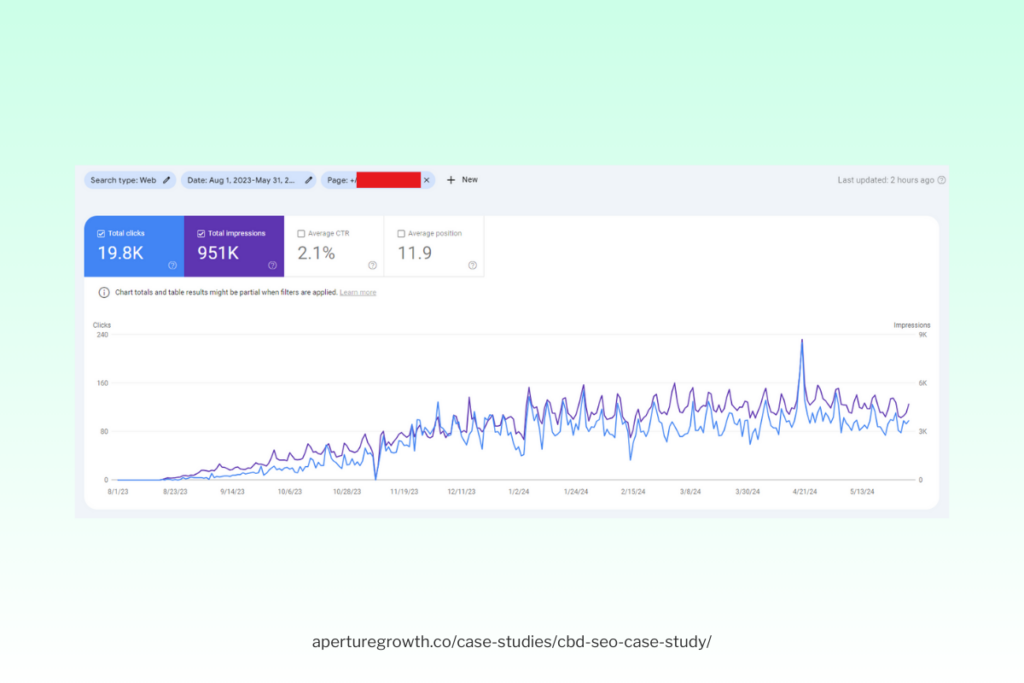
This blog post received over 7,000 clicks after it began ranking in October, for an average of almost 1,000 per month:
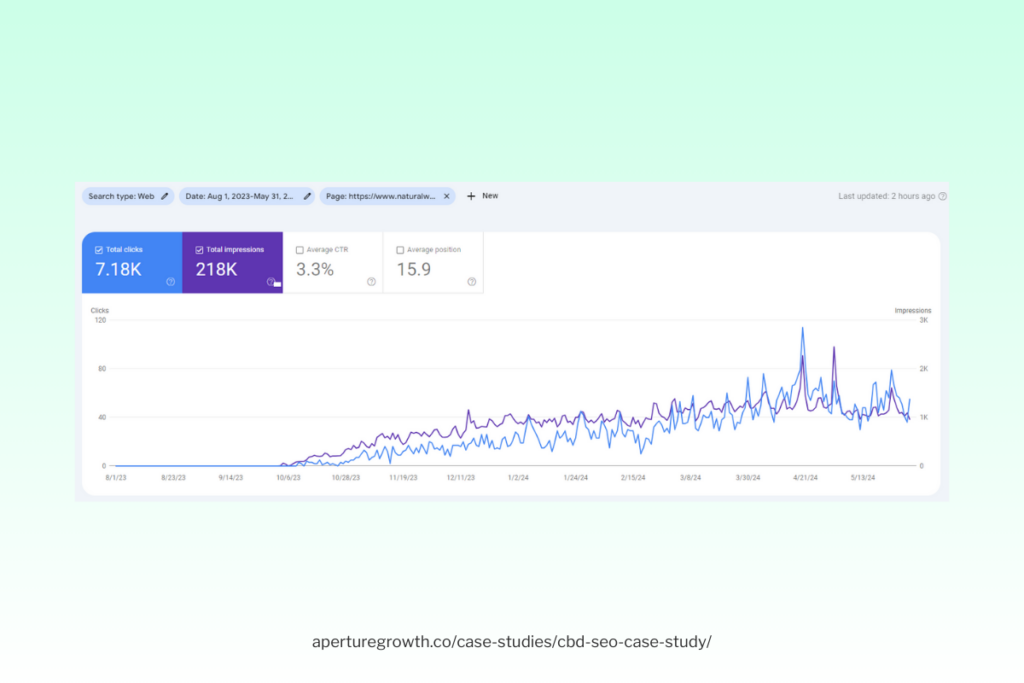
Between August 1st, 2023 and May 31st, 2024, this is what the growth in clicks on Natural Ways CBD’s blog posts looked like:
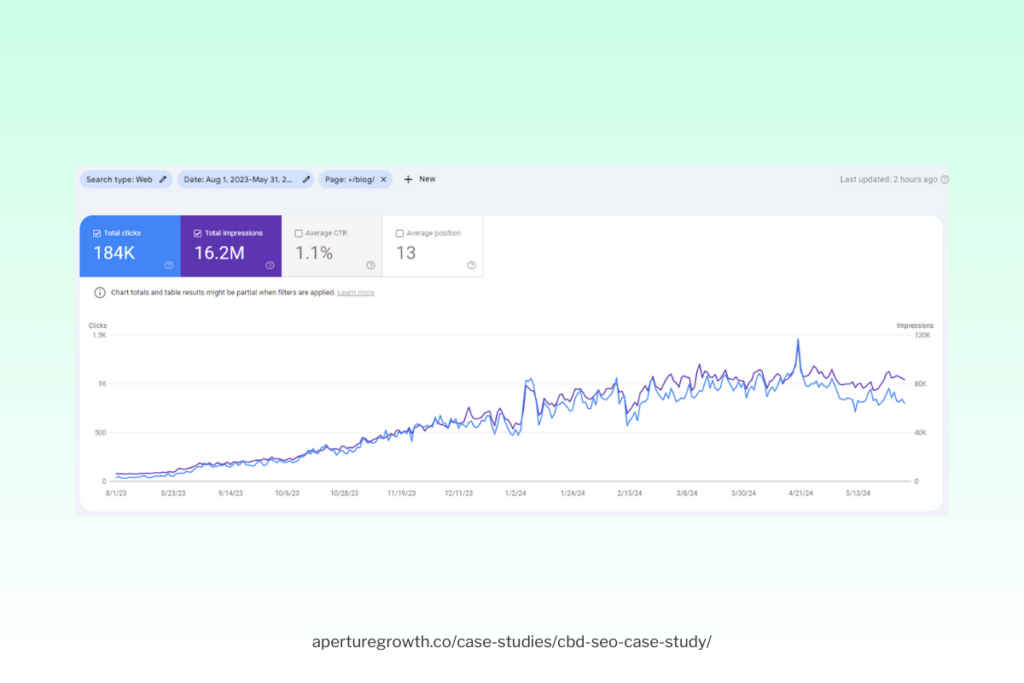
Our Takeaways from Working with Natural Ways CBD
Going into this project, there were budget and design issues that meant we had to adapt and execute a “partial” SEO strategy:
- We didn’t build out new product category pages for them
- We didn’t build links for them
Because we couldn’t put our full CBD e-commerce SEO cookbook into action, results came slower than they usually do.
But despite this, we were able to increase their organic revenue by more than 10k per month and provide them with a better-than-3x ROI on their total spend with us (the money we made for them in a 10-month period was more than 3x what they paid us in this same period).
What this CBD SEO case study demonstrates is that it’s possible for CBD brands with minimal online presence to go from getting few, stagnant online sales to building out an additional six-figure revenue channel.
And despite rising competition, AI content, AI features in search, and the many other challenges SEOs have had to overcome in the past 2 years, SEO is still very much a profitable channel for CBD brands to invest in, as long as the strategy and execution are on point.
To any business in the same position that Natural Ways CBD was in when they came to us last August, here’s what we’d recommend:
- Build and optimize all of your category and product pages first: Chances are, there are a few profitable ranking opportunities that you can get in a matter of weeks.
- Focus on high-quality blog content: This will help your lucrative pages rank while also driving traffic, email signups, and additional revenue; blog content should be a regular part of your SEO strategy
And with that, we close. If you’re a CBD brand owner or marketer and are interested in having us achieve these results for your brand, click here to learn more about our services.
Want These Results for Your CBD Brand?
- If you want us to grow your eCommerce CBD brand’s revenue, email signups, and traffic, visit our CBD SEO services page to learn more about our SEO process and how we work. We’re a small agency with a relentless focus on driving actual business results from SEO and we only work within the cannabis and CBD industry. We have what it takes to help your brand grow.
- If you want to do your own SEO, check out our blog and YouTube channel, where we publish new in-depth resources every week on how to do SEO in the cannabis and CBD space.

